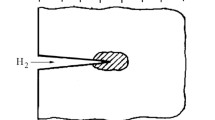Based on the structural concept of threshold stress intensity factor ranges, the model, describing the growth kinetics of physically small and long cracks, was constructed. The model permits the calculation of lifetime on the growth of physically small and long cracks at regular cyclic uniaxial loads by the data on static mechanical characteristics and a microstructure of the initial material. The model validity was corroborated by fracture toughness results in symmetric cyclic plane bending of VT3-1 titanium alloy specimens in different microstructural states. Calculated kinetic fatigue fracture diagrams are in good agreement with experimental results.





Similar content being viewed by others
Abbreviations
- a, c, h :
-
hexagonal close-packed (hcp) crystal lattice parameters
- b :
-
Burgers vector (\( \overline{b} \)) module
- d :
-
linear dimension of the microstructure element responsible for the fatigue strength of a material [grain size, maximum depth of a microstructurally short crack (MSC), minimum depth of a physically small crack (PSC)]
- E :
-
elastic modulus
- ΔK :
-
stress intensity factor (SIF) range
- K Imax :
-
maximum SIF of the mode I cycle
- ΔK th,d :
-
threshold SIF range for MSC
- ΔK th,l :
-
threshold SIF range for PSC
- ΔK th :
-
threshold SIF range for long cracks (LC)
- ΔK th,eff :
-
effective threshold SIF range
- ΔK T :
-
SIF range for the PSC-to-LC growth
- l :
-
surface half-penny crack depth
- l s :
-
intermediate PSC depth at σ a = σ–1
- l i :
-
intermediate PSC depth at σ–1 < σ a < σ p
- l ′ i :
-
final PSC depth (initial LC depth)
- l t :
-
final LC depth (fatigue fracture criterion)
- M :
-
Taylor factor (M = 1/m s )
- m s :
-
Schmid factor (m = cos φ cos γ)
- φ:
-
slip plane normal–load direction angle
- γ:
-
slip direction–load direction angle
- μ:
-
Poisson’s ratio
- N :
-
number of load cycles
- R :
-
stress ratio
- r p,c :
-
cyclic plastic zone size
- σ a :
-
cycle stress amplitude
- σmax :
-
maximum cycle stress
- σ–1 :
-
endurance limit at the symmetric load cycle
- σ p :
-
proportionality limit
- σ f :
-
internal friction stress in the crystal lattice
- Y, Y 1, Y 2 :
-
geometric factors (SIF correction)
References
D. Davidson, K. Chan, R. McClung, and S. Hudak, “Small fatigue cracks,” Comprehensive Structural Integrity, 4, 129–164 (2003).
O. M. Herasymchuk and O. V. Kononuchenko, “Model for fatigue life prediction of titanium alloys. Part 1. Elaboration of a model of fatigue life prior to initiation of microstructurally short crack and a propagation model for physically short and long cracks,” Strength Mater., 45, No. 1, 44–55 (2013).
O. M. Herasymchuk and O. V. Kononuchenko, “Model for fatigue life prediction of titanium alloys. Part 2. Model testing and analysis of obtained results,” Strength Mater., 45, No. 2, 163–170 (2013).
I. Marines-Garcia, P. C. Paris, H. Tacla, and C. Bathias, “Fatigue crack growth from small to long cracks in VHCF with surface initiations,” Int. J. Fatigue, 29, 2072–2078 (2007).
O. M. Herasymchuk, “Relationship between the threshold stress intensity factor ranges of the material and the transition from short to long fatigue crack,” Strength Mater., 46, No. 3, 360–374 (2014).
Standard Test Method for Measurements of Fatigue Crack Growth Rates, ASTM STP E647-00 (2000).
K. Sadananda and A. K. Vasudevan, “Short crack growth and internal stresses,” Int. J. Fatigue, 19, S99–S108 (1997).
O. M. Herasymchuk, “A generalized grain-size dependence of the fatigue limit,” Strength Mater., 43, No. 2, 205–216 (2011).
R. W. Hertzberg, “A simple calculation of da dN data in the near threshold regime and above,” Int. J. Fract., 64, R53–R58 (1993).
V. V. Panasyuk (Ed.), Fracture Mechanics and Strength of Materials. Reference Book [in Russian], in 4 volumes, Vol. 2: M. P. Savruk, Stress Intensity Factors in Cracked Bodies, Naukova Dumka, Kiev (1988).
Author information
Authors and Affiliations
Additional information
Translated from Problemy Prochnosti, No. 2, pp. 48 – 60, March – April, 2015.
Rights and permissions
About this article
Cite this article
Herasymchuk, O.M. Microstructure-Dependent Model for Calculating the Growth Rate of Physically Small and Long Fatigue Cracks. Strength Mater 47, 257–267 (2015). https://doi.org/10.1007/s11223-015-9656-9
Received:
Published:
Issue Date:
DOI: https://doi.org/10.1007/s11223-015-9656-9




